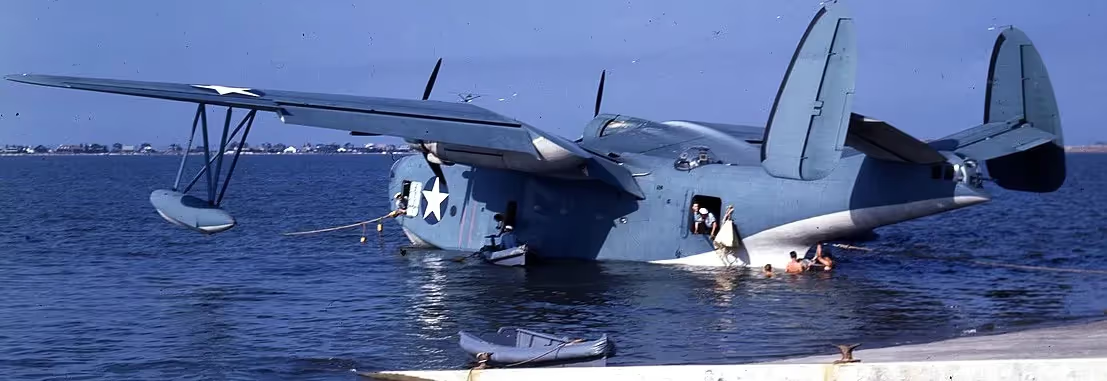Warplanes of the USA: Martin PBM Mariner
Martin PBM-3C Mariner

(USN Photo)
Martin PBM-3C Mariner patrol bomber flying over the water, near Naval Air Station Norfolk, Virginia (USA), in September 1942. Note AN/APS-15 radar atop this aircraft.
The Martin PBM Mariner is a twin-engine American patrol bomber flying boat of the Second World War and the early Cold War era. It was designed to complement the Consolidated PBY Catalina and PB2Y Coronado in service. A total of 1,366 PBMs were built, with the first example flying on 18 Feb 1939, and the type entering service in Sep 1940, with the last of the type being retired in 1964.
The aircraft had multiple gun positions including single mounts at each midship beam and stern above the tail cone. Additional guns were positioned in the nose and dorsal turrets, each fitted with two-gun turrets. The bomb bays were in the engine nacelles. The gull wing was of cantilever design, and featured clean aerodynamics with an unbraced twin tail. The PBM-1 was equipped with retractable wing landing floats that were hinged outboard, with single-strut supported floats that retracted inwards to rest beneath the wing, with the floats' keels just outboard of each of the engine nacelles. The PBM-3 had fixed floats, and the fuselage was three feet longer than that of the PBM-1. Martin also developed the even larger 4-engined Martin JRM Mars in this period.
The first PBM-1s entered service with Patrol Squadron Fifty-Five (VP-55) of the United States Navy on 1 September 1940. Prior to the USA's entry into the Second World War, PBMs were used (together with PBYs) to carry out Neutrality Patrols in the Atlantic, including operations from Iceland. Following Japan's attack on Pearl Harbor, PBMs were used on anti-submarine patrols, sinking their first German U-boat, U-158, on 30 June 1942. PBMs were responsible, wholly or in part, for sinking a total of ten U-boats during the Second World War. PBMs were also heavily used in the Pacific War, operating from bases at Saipan, Okinawa, Iwo Jima, and the South West Pacific.
PBMs continued in service with the U.S. Navy following the end of the Second World War, flying long patrol missions during the Korean War. It continued in front line use until replaced by its successor, the P5M Marlin. The last Navy squadron equipped with the PBM, Patrol Squadron Fifty (VP-50), retired them in July 1956. (Wikipedia)

(USN Photo)
Martin PBM-3 Mariner in flight, 1942-43.
.avif)
(USN Photo)
Four U.S. Navy Martin PBM Mariners in flight near Naval Air Station Banana River, Florida (USA), in March 1943. The two PBM-1s are without wing floats, the two PBM-3s have wing floats.

(USN PHoto)
Martin PBM-3R Mariner transport aircraft (BuNo. 6465) taking off, circa 1942-43.

(USN Photo)
Martin PBM-3 Mariner is being rigged for beaching at Naval Air Station Norfolk, Virginia (USA), circa mid-1942.

(USN Photo)
Martin PBM-3D Mariner under way on the water at Naval Air Station Pensacola, Florida (USA), in 1944.

(USN Photo)
Martin PBM-5S Mariner (BuNo 59256) of Patrol Squadron 50 (VP-50) "Blue Dragons" in flight, April 1956. VP-50 became the last active duty U.S. Navy patrol squadron to replace its PBMs with the new Martin P5M-2 Marlin in June 1956.

(USN Photo)
Martin PBM-5 Mariner from Patrol Squadron VP-47 Golden Swordsmen at Naval Air Station Kaneohe Bay, Hawaii. VP-47 was reassigned to NAS North Island, California (USA), on 2 March 1949. In the background are Consolidated PB4Y-2 Privateer aircraft from VP-22 Blue Geese Squadron which was based at NAS Kaneohe Bay between 2 July 1948 and 1 May 1949.

(USN Photo)
Crewmen of U.S. Navy Patrol Squadron 46 (VP-46) "Grey Knights" perfom a 60 hour-check on a Pratt & Whitney R-2800 engline of one of the squdron's Martin PBM-5 Mariner patrol planes at Naval Station Sangley Point, Philippines, 2 March 1953. In September 1953, VP-46 transitioned to the Martin P5M-1 Marlin.

(USN Photo)
Martin PBM-3S Mariner of patrol bombing squadron VPB-211 off Brazil, 1943-1945.

(USN Photo)
Martin PBM Mariner Towed to Hangar for Repairs at NAS Norfolk, Virginia, 1945.

(USN Photo)
Martin PBM Mariner flying boat of Fleet Air Wing 6 is hoisted aboard the U.S. Navy seaplane tender USS Curtiss (AV 4) after returning from a mine-hunting patrol off North Korea during the Korean War.

(USN Photo)
Martin PBM-3C Mariners of Patrol Squadron 201 (VP-201) at Naval Air Station Banana River, Florida, 13 January 1943.

(USN Photo)
Martin PBM-3 Mariner of Patrol Squadron 74 (74-P-3), 1942.

(USN Photo)
Martin PBM-1 Mariner of Patrol Squadron 55 (VP-55) in flight, circa in 1940-1941.

(USN Photo)
Martin PBM Mariner in US service in 1942.
_and_PBM_Mariner_c1946.avif)
(USN Photo)
Martin PBM Mariner taxis in front of the aircraft carrier USS Tarawa (CV-40), in 1946-47. On deck are various aircraft of Carrier Air Group 4 (CVG-4).

(NARA Photo)
Beaching crew clings to bow line of twin-engine patrol bomber seaplane at Naval Air Station in Banana River, Florida.

(USN Photo)
Martin PBM Mariner patrol bomber seaplane being hosed down after it was hauled up ramp at aval Air Station in Banana River, Florida., ca. March 1943.

(USCG Photo)
U.S. Coast Guard Martin PBM-3G or PBM-5G Mariner taking off from the water using Rocket Assisted Take-off (RATO, c late 1940s.
.avif)
(Bill Larkins Photo)
Martin PMB-5G Coast Guard, San Francisco Coast Guard Station.

(USCG Photo)
US Coast Guard salvage operations on US Navy PBM plane (P-81), which grounded on a coral reef of Carti Village, Gulf of San Blas, Panama on 22 Sep 1944. USCGC Sweetgum floated the plane and hoisted same on an Army barge.

(IWM Photo, MH 5017)
Royal Air Force Coastal Command Martin PBM-3B Mariner I (Serial No. JX103) of No. 524 Squadron at Oban, Scotland, in October 1943. The squadron was assessing the aircraft, but in the end the type was not adopted by the RAF, and in 1944 No. 524 re-equipped with the Vickers Wellington XIII.
The RAF acquired 32 Mariners, designated Mariner I, (PBM-3B), but they were not used operationally, with some returned to the United States Navy.

(Arjan Koning Photo)
Martin PBM-5A Mariner, Royal Netherlands Naval Air Service, shown shortly after delivery, and before the RNAS roundel has been applied.

(Mike Freer - Touchdown Aviation Photo)
Martin PBM-5A Mariner prior to its restoration at the Pima Air And Space Museum in Tucson, Arizona, 1989.

(Aaron Headly Photo)
Martin PBM 5-A Mariner on display at the Pima Air and Space Museum near Tucson, Arizona.





